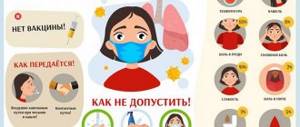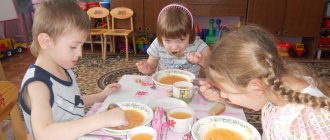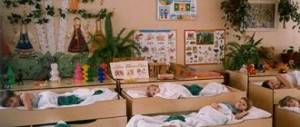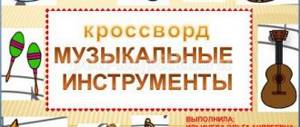Formation of self-care skills in children of primary preschool age
Dear friends, we are pleased to introduce you to Irina Aleksandrovna Redkina, a teacher at the Neftyanik Kindergarten, Tara, Omsk Region. Today Irina Aleksandrovna shares her experience in developing self-service skills in children of primary preschool age. The article will be useful to preschool teachers.
A short commentary on the article from Irina Alexandrovna:
“Formation of self-care skills in children of primary preschool age plays a vital role in protecting their health and promotes correct behavior in everyday life.”
Useful reading...
Formation of self-care skills in children of primary preschool age
The formation of self-care skills in children of primary preschool age plays a vital role in protecting their health and promotes correct behavior in everyday life. In the process of everyday work with children, it is necessary to strive to ensure that following the rules of personal hygiene becomes natural for them, and hygiene skills are improved. Self-care skills in children are cultivated from a very early age; in the formation of cultural and hygienic skills, there is not a simple assimilation of rules and norms of behavior, but an extremely important process of socialization of a child of primary preschool age. Mastering self-care skills (the ability to dress and undress, take care of oneself, use the toilet, eat independently, bathe, wash, etc.) directly affects the child’s self-esteem and is an important step towards his independence. Teaching self-service skills allows you to effectively solve the problems of expanding children's ideas and knowledge about surrounding things, sensory education, speech development, fine motor skills and hand-eye coordination, as well as the ability to perform actions of imitation and verbal instructions, focus on a model, and follow a certain sequence of actions.
Unfortunately, recently more and more parents are overprotective of their children. Some parents often do everything for their children: clothing, feeding, believing that their child is still small or simply in a hurry to get somewhere. This leads to the child not developing independence in self-care skills. In connection with the above, the problem of developing self-service skills in children of primary preschool age arises.
The pedagogical idea of my experience is to search for the necessary forms, methods and technologies for developing self-care skills in children of primary preschool age.
Goal of the work:
Formation of self-care skills in children of primary preschool age.
Tasks:
-Develop the ability to monitor one’s appearance, independently perform micro- and holistic self-care processes associated with certain physical activities that require the development of fine motor skills.
-Expand a clear understanding of items of clothing and footwear, as well as their purpose and methods of use, rules for handling items for children's self-care.
-Nurture the first manifestations of cooperation with peers, developing empathy, emotional responsiveness, and the ability to use generally accepted methods of providing and accepting help
THEORETICAL PART
Self-service is the beginning of the labor education of a preschooler; the formation of self-service skills is of paramount importance for the mental development of the child as a whole. Mastering self-care skills (the ability to dress and undress, take care of yourself, use the toilet, eat independently, wash yourself, etc.) directly affects the child’s self-esteem and is an important step towards his independence.
The formation of self-care skills in preschool children was studied by Z.N. Borisova, R.S. Bure and other teachers.
The child’s first labor actions are related to self-service. How difficult it is for a baby to cope with the process of dressing! And how persistently he tries to show independence!
Independence is the most important psychological new formation that arises on the border of early preschool childhood, the central characteristic of the age of three years: The crisis of three years is a crisis of “I myself!”, caused by the destruction of the existing system of relations with adults that no longer corresponds to the increased strength of a child of this age.
Timely mastery of self-service processes gives the child the opportunity to assert himself, feel independent and skillful. The gradually formed habit of cleanliness, neatness and neatness provides the basis for familiarization with a hygienic culture and a healthy lifestyle [3].
Skills are those actions that are performed with partial automation of the elements that make up them. Thanks to the formation of a skill, a person’s consciousness is freed from the need to control the execution of individual movements that make up the action, and switches to its goals and conditions of execution. A child who has mastered the skill of washing hands no longer thinks about how to perform individual movements. He can now ensure that he does not splash water, spill his clothes, etc.
When a skill is formed, a number of partial movements merge into one complex one. Extra, unnecessary movements are eliminated, the pace is accelerated. The transition from one movement to another occurs as if by itself, without special planning. The formation of automated actions, such as skills, is possible thanks to special processes occurring in the cerebral cortex during the child’s activities.
Academician I.P. Pavlov proved that under the influence of external influences, temporary connections are formed in the cerebral cortex. Individual temporary connections, or conditioned reflexes, form a strong system if the influences that caused them follow repeatedly in the same sequence.
Skills are strengthened as a result of repeated performance of an action, as a result of exercises in its correct execution. If a child makes mistakes while repeating an action, the required skill will not be developed.
Acquired skills become stable and difficult to re-educate. Therefore, it is important to teach children to perform the action correctly from the very beginning.
Self-care is a type of household labor that includes hygienic personal care, caring for one’s clothes, belongings, home, as well as cooking, repairing and making things needed in everyday life, etc.
Self-service is closely related to labor education. Labor education of a child begins with teaching him to self-service. Adults take the first steps in this direction already when they teach the child to wash his hands and face, brush his teeth, get dressed, make his bed, etc. on his own.
It is important not only to teach the child to perform all these operations, but also to form the habit of self-care. To cultivate such a habit means to accustom the child so that he not only does not forget about his responsibilities, but also feels the need to fulfill them. A person brought up in this regard cannot, for example, sit down at the table without washing his hands, cannot remain in an uncleaned room, etc.
The habit of self-care arises from the constant, day after day repetition of a certain action. Adults must patiently teach self-care responsibilities. At the same time, it is necessary to take into account that even the simplest actions of a child must be taught, shown and explained how and what to do. Gradually, the number of child’s self-care responsibilities increases, and their content becomes more complicated. Both girls and boys are equally accustomed to self-care work. The ability to serve oneself is necessary for both. It is necessary that every child grows up skillful, hardworking, and not afraid of work.
Children acquire the simplest skills of individual self-care in preschool age. Immediately after the child begins to walk and pronounce the first words, you can and should begin to gradually develop in him the ability to dress, wash, eat, put away his toys, etc. on his own. Developing these primary labor skills and abilities is a complex and lengthy process. Parents and educators should not be afraid that the child will not succeed in many things for a long time, or will do poorly. Their help to the child from the very beginning should be unobtrusive, tactful, not restricting the child’s independence and not undermining his faith in his capabilities and strengths.
B.P. Nikitin writes that for the development of a child of primary preschool age, the following conditions must be met: 1) early start 2) creation of an environment conducive to the child’s developmental activity and stimulating it 3) organization of maximum effort in the process of this activity, reaching the ceiling opportunities 4) providing greater freedom in choosing activities 5) assistance from adults[.
Thus, self-care for children in preschool educational institutions is one of the main types of work of preschoolers. In the younger group, children’s self-care is expressed in independent undressing, dressing, washing, etc. When developing self-service skills, repeatability and consistency of requirements, benevolent control on the part of the teacher, his personal example, as well as the example of children who possess the relevant skills are of great importance.
I work in a preschool age group. At the beginning of the school year, I diagnosed the level of development of self-service skills in children of primary preschool age, authors T.I. Babaeva, A.G. Gogoberidze, Z.A. Mikhailov educational region “Labor” section “I myself!” It was found that most children have not developed self-care skills. Most children perform actions with the help of an adult; the desire for independence is not sufficiently expressed; they expect help even in mastered microprocesses.
To solve this problem, I planned an algorithm of actions: studying scientific and methodological literature on the topic “Formation of self-service skills in children of primary preschool age”; selection of technologies, effective methods and techniques for work; applying them in practice; re-diagnosis; generalization of the obtained results.
Having studied the scientific and methodological literature, I came to the conclusion that self-care is the work of a child aimed at serving himself (dressing and undressing, eating, sanitary and hygienic procedures). The quality and awareness of actions varies from child to child, so the task of developing self-service skills is relevant at all age stages of preschool childhood.
For the successful formation of self-service skills, the creation of a subject-development environment is of great importance. Practice shows that when performing self-service operations, children, putting on a dress or putting away toys, make many unnecessary, erratic movements. They waste a lot of energy, but the quality of work remains poor. Therefore, when checking how children cope with self-care, you need to teach them to avoid unnecessary movements.
When assessing how a child washed himself, put away his toys, or hung up his laundry, it is not enough to tell him: “Well done” or “Wrong.” The assessment of work activity should contain an emphasis on the child’s current achievements and what is still not working well. Children should not be praised for things that do not deserve praise. It must be borne in mind that objective assessment helps strengthen in children the desire to do everything themselves, the desire to work better, the ability to overcome difficulties, and achieve results.
Having studied the technology of educational games B.P. Nikitin, in the work on developing self-care skills in younger preschoolers, I included the author’s additions to tasks that do not require separate materials, but are independent games. From the recommendations for organizing educational games, I chose the most important points related specifically to my topic of work.
1). Rejoice at success, not praise.
Any games only produce results when kids play with pleasure. The first condition for success is a smile, joy, praise, sincere interest of elders in the progress of the baby, in the growth of his strength. At the same time, of course, we must not forget that overpraising—praise that is not deserved—can also cause harm, especially at an older age. You always need to be able to show a child, as it were, the reserve of his capabilities, what is possible even better.
2). You won’t be nice by force, but the forbidden fruit is sweet.
Very often, wanting to instill something in a child, they persistently and obsessively repeat the same thing to him. There is no better way to achieve the exact opposite result. And vice versa: prohibition and inaccessibility always arouse interest and a desire to find out what it is. This pattern should definitely be used when communicating with children. And in games too. When the child begins to play independently, without adults, that is, when interest in educational games develops and strengthens, then you can find, together with the baby, another place accessible to him, and instruct him to keep order in the games, take them when he wants, invite other kids to play. But at the same time, of course, you should check the order from time to time. To do this, you just need to play with the children. And the game itself will show how he copes with his responsibilities.
3). By the will of the "waves"
How many new games should we give at once? And how to enter them? After all, there are a lot of games, you need to somehow combine them with one another. Here again it is impossible to give strict recommendations. These issues must be approached creatively, keeping in mind the main goal - the successful development of the child, the growth of his abilities - and remembering that play should bring joy. Of course, it is unwise to give your child many new games at once. Excess immediately leads to their depreciation. It is better to introduce them gradually and at the “right moment”.
4). Relaxed atmosphere
Any game requires a relaxed, free environment, when all attention is focused on the game itself, and not on “sit properly,” “don’t swing your legs,” “don’t jump up from your seat,” and “don’t make noise.”
5). "Monkey."
Children 3 years old usually look like monkeys. Watching his elders, copying their actions, the child learns and learns more successfully the more accurately he repeats these actions, although he does not always understand their meaning. Since I work in a mixed-age group, this method is very effective when dressing, undressing, and washing students.
The main activity of young children is play. I tried to organize it so that children in games would master the skills necessary for self-care. They sewed dresses for the dolls and knitted blouses with buttons. First, in the presence of children, they dressed the dolls for a walk, undressed them, put them to bed, showed them how to button and unbutton clothes, somewhat slowing down the actions and accompanying them with explanations. Then, in a joint game with the child, they asked him to perform this or that action.
In order for children to learn how to tie shoes, it was necessary to develop the fine muscles of their hands. To do this, we used the didactic games “Lacing”, “Frames and Inlays”, “Mosaic”.
Objects were placed in the dressing-up corner, the use of which forced children to practice tying and fastening (collars, aprons, sweaters, etc.). To attract the children's attention to the dressing-up corner, a brightly decorated chest was brought in, which immediately interested them. We have a large mirror so the children can see themselves. Dressing up brought a lot of joy and revitalization. In the game they learned to fasten and tie.
When developing the skills of dressing and undressing, first of all, I taught the children to perform actions consistently and rationally; for this, in the locker room I hung illustrations with the algorithm for dressing and undressing. They explained that before putting on knee socks, you need to assemble them with an accordion, and start putting them on with the sock; before putting on sandals, they must be placed so that they “look at each other, and do not get angry, do not turn away”; to put on a T-shirt or sweater correctly, you must first determine where the front is; The jacket should first be laid out on a bench and then put on. At the same time as the explanation, they showed the children how to assemble knee socks with an accordion and pull them on correctly, how to determine the front of a T-shirt (by the pattern, by the collar, etc.) and how to put it on correctly. All this helped children quickly master the necessary dressing skills. Gradually, I moved from direct help to reminders, and tried to do it unobtrusively so as not to distract other children. For example, if children put on tights incorrectly, they were told: “Check them and put them on your knees so that there is one seam at the top.” When teaching children self-service skills, we did not forget about such an effective technique as encouragement.
I also taught children independence during mealtimes, using techniques such as pointing with explanations. So, while dining at the same table with the children, they showed how to eat correctly, how to hold a spoon, fork, and offered to take the spoon the way the teacher does. I used game techniques, for example, the cat Musya came to visit our group and really wanted to see how we learned to use a napkin. Conducted didactic games: “Let’s treat the doll to tea,” “Let’s feed the doll,” etc.
She showed small performances to the children, for example: “Mishutka came to visit the bunny”, “Mashenka learn how to hold a mug correctly.”
When developing washing skills, it is important not to hamper children’s independence. At first, I was more active than a child. Taking the baby to the sink, I said: “You wash yourself, and I’ll help you, otherwise your hands are very dirty.” At the same time, unnoticed by the child, they helped him wash himself carefully and cleanly.
By developing self-service skills, we also cultivated a caring attitude towards things. They showed and told how to fold things, hang them in a closet, and used fiction (“Fedorino’s grief,” “Moidodyr,” “Masha put on a mitten...”). I have developed a card index of nursery rhymes and poems, which I use in special moments, developing self-service skills in preschoolers.
At my request, the nanny taught the doll Tanya to wash her hands: she rolled up her sleeves, turned on the water in a thin stream and began to wash her hands on both sides, and I explained her actions. After just two months, the children had developed fairly solid skills, which made it possible to complicate the requirements, for example, teach them how to roll up their sleeves (first with the help of an adult). As individual children mastered this skill, I involved them in helping their peers and made higher demands on the quality of washing. I also gradually taught the children how to use a towel correctly: they showed how to hold a towel, how to dry themselves, and encouraged those who do it correctly. After washing, we drew the children’s attention to their appearance and noted that they were clean and neat. As a result, all the children went to wash their hands without being reminded, rolling up their sleeves on their own, using soap and water correctly, and drying their hands with a towel.
In developing self-service skills, the consistency of the requirements placed on children by the family and teachers, and the coordination of the work of the family and kindergarten are of great importance. The family teaches children self-care and provides them with initial skills and abilities. Kindergarten reinforces and develops them.
Cultural and hygienic skills in the senior group: a card index with goals
In order to relieve the teacher of filling out and completing written documentation, in kindergartens, methodologists and teachers themselves use special cards that are created once and used constantly.
Self-care techniques
The card file, unlike planning, is not mandatory documentation for the teacher, but it greatly facilitates and structures the work. When creating a card index, the teacher relies on the material and technical equipment of the preschool institution, the age-related psychophysiological needs of the pupils and the requirements of the educational program. At the moment, all educational programs must comply with the Federal State Educational Standard (FSES).
Self-care skills as the basis of cultural and hygienic education
Self-care skills are part of the general and labor education of a child. A culture of behavior in everyday life promotes health preservation and the development of such personal qualities as willpower, organization, punctuality and discipline.
To a greater extent, cultural and hygienic skills are laid in early childhood, since it is during this period that the central nervous system is most pliable, and self-care skills are repeated day after day.
Note! However, in the senior preparatory group of a preschool educational institution, these qualities should be strengthened and improved, creating conditions for the further formation of useful habits.
Creating conditions for developing hygiene skills in preschool educational institutions according to the Federal State Educational Standard
In order to develop self-care skills and their further use in everyday life at home and in kindergarten, conditions that dictate the Federal State Educational Standard must be created in the group of a preschool educational institution. Such conditions in the senior group of kindergarten include:
- the presence of a room that meets all the requirements: dining room, toilet room, bedroom, play area;
- the presence of the required number of personal hygiene products: aprons, dishes, combs, towels and other things;
- constancy and systematicity of conditions (for example, each child always eats and sleeps in his own place);
- maintaining a daily routine (constantly changing activities and knowing the time prevents the nervous system from being overloaded during the day);
- unity of requirements (conditions must be met both in the group and at home).
Note! The first and main condition for the formation of a group of children at any age is a competent teaching staff that will take into account the age and individual personality characteristics of each child.
How to teach your child the days of the week in a playful way
Competent teaching staff
Instilling KGN in the senior group: compiling a card index with goals according to the Federal State Educational Standard
For the most effective work of the teacher in instilling cultural and hygienic skills in the senior group, a detailed card index is compiled. It is a diagram or perspective plan in a table, which contains the following sections:
- The topics of classes and the forms of their implementation (conversations, reading, exercises, role-playing games, productive activities).
- Distribution of classes by month (January, February, March, April, etc.), seasons (winter, summer) or quarters of the year (first, second quarter).
- Educational goals of the classes.
Note! The topics of classes in the senior group may include behavior at the table, teaching politeness, relationships with peers, and others.
Examples of poems for the development and inculcation of KGN
To instill KGN and rapid learning, educators use poetic form. These can be small quatrains or entire large poems around which the lesson will be built.
For example, the poem “Jam” by O. Grigoriev or “Purity” by D. Krupskaya, which talk about incorrect behavior and lead children to important conclusions. “Bad Advice” by G. Oster, poems by E. Moshkovskaya and A. Barto, “Moidodyr” and “Fedorino’s Mountain” by K. Chuikovsky, “What is good and what is bad” by V. Mayakovsky and other nursery rhymes and riddles have great educational potential in poetic form.
Moidodyr
Also, educators can independently come up with fairy tales that contribute to the development of not only moral qualities, but also hygiene skills. Adventures of a comb, stories about a toothbrush, tales of politeness and cooperation with other people.
Methods and techniques for developing cultural and hygienic skills in children 5–6 years old
In older preschool age, the importance of speech techniques in the educational process increases. Other methods of interaction are used no less, but the emphasis is on verbal forms.
Speech methods for developing cultural and hygienic skills include:
- Conversation. Using this technique, you can explain to preschoolers the culture of communication and treatment, caring for your things, and the importance of cultural behavior at the table.
- Puzzles. They have a good ability to motivate. They interest the children in further development of the topic, attract attention and set them in a working mood. Most often used at the beginning of a lesson.
- Reading, poems. Can be used individually or in combination with each other.
- Visibility. This method includes demonstrations (the teacher first shows how to make the bed correctly), illustrations (story pictures that can be discussed) and showing cartoons, presentations and videos.
- A game. Moving, didactic or role-playing. The game can also be used at the beginning of a lesson as an element of motivation.
Breathing exercises for children in preschool educational institutions
Didactic game “Clean Crocodile”
An example of a didactic game is “Clean Crocodile”. The goal of the game is to consolidate self-care skills and develop a careful attitude towards one’s health. The students' task is to recognize the process associated with any hygiene skill. The teacher shows with gestures how he dresses or brushes his teeth, and the preschoolers guess.
Didactic game “Good or bad?”
Didactic game "Good or bad." The purpose of this exercise is to consolidate the ability to evaluate one’s own and others’ actions, develop the ability to cooperate and
accumulation of relationship experience. The game has many options for playing. One of them is to look at cards with stories that depict bad and good deeds.
Note! Children are asked to collectively classify these cards into “Good” and “Bad”. You can also collect pairs of cards that depict good and bad actions in the same situation.
Role-playing game “The doll is bathing”
An example of a role-playing game is the exercise “The doll is bathing.” The goal is to develop interest in work, develop friendly communication and educate KGN. Children, together with the teacher, must bathe the doll, while together selecting bathing products (washcloth, shampoo, towel), adjusting the comfortable temperature of the water, indicating the importance of putting on clean clothes after washing. You can also continue this game with the exercise “Wash things” or “Put things on shelves.”
The doll is bathing
Board and printed game “How I spend my day”
To consolidate knowledge about the daily routine, you can use the printed game “How I spend my day” at work.
Children are offered illustrations that depict routine moments. Their task is to distribute the correct sequence of all stages of the day along the chain.
In older preschool age, unlike middle and younger children, children already know how to wash themselves, brush their teeth, and are able to make the bed and put away the dishes. But at this age, an important stage of development is the consolidation of cultural and hygienic skills acquired earlier. Only well-developed skills recorded in everyday life will become the basis of a cultural personality who treats himself and others with care.








